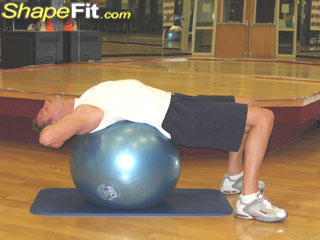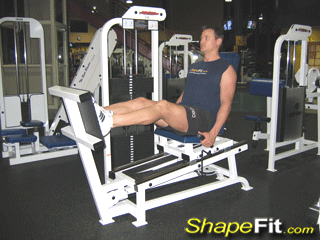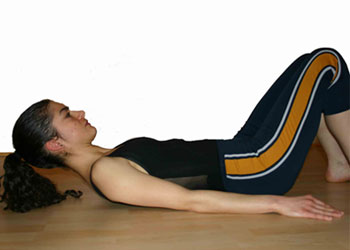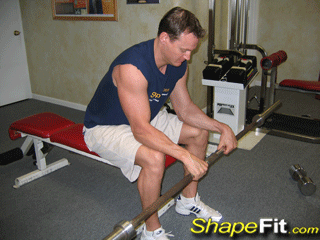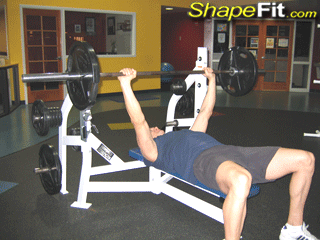One Arm Barbell Rows – Back Exercise Guide with Photos
Muscles Targeted: One arm barbell rows target your middle back, biceps, lats and shoulders. The row is intended typically to work your latissimus dorsi, rhomboids, erector spinae and lower lats, and requires quite a large degree of stabilization by the rotator cuff. This means that in the case you’re doing it correctly, you should feel the muscles between and below the shoulder blades working like crazy.
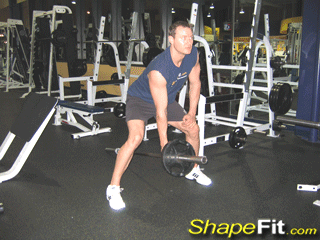
Exercise Instructions: Grab a barbell and get in an area where you have a good amount of room. Straddle the barbell and grab it with one hand. Bend forward at your waist so that your chest is leaning forward over your feet. Keep your knees slightly bent and your feet just beyond shoulder width apart. Start with your arm fully extended, allowing the barbell to hang at about mid-shin level. Next, lift or “row” the barbell up and close to your stomach area. Return to the starting position and repeat for the desired number of repetitions to finish the set and then repeat with the opposite arm. Be sure to keep your head up and shoulders back throughout this exercise to keep your back in a firm and stable position.
Why This Exercise is Important: This exercise provides increased strength and flexibility in your lower back, but your primary benefit will be in the upper back. Your forearms, lower back, biceps and shoulders will benefit also. Furthermore, it emphasizes the entire latissimus dorsi area, the upper back, and the trapezius muscles. Lastly, it’s one of the most versatile “bang for your buck” upper body exercises you have in your arsenal. The movement involves scapular retraction plus depression, alongside with spinal extension and compression through your thoracolumbar region, and also acts like a base stabilization exercise through anti-rotation and anti-flexion. Your spinal position will influence shoulder mechanics. As your lats are supposed to retract plus depress your scapula, the row movement only works properly in the case that the spine isn’t stuck in kyphosis (rounding of the back).
Things To Avoid: On the eccentric portion of this exercise, do not drop the weight down and let your elbows “snap” or your shoulders “slump” from the falling weight. Also, do not twist your body or allow your back to round or let your shoulders hunch. Technique and form is everything with this exercise. A rounded back will limit the mobility of your scapula and make the exercise almost impossible to target your lats. By “straightening out” your spine and getting it into a neutral position, you allow your shoulder blade to move as it should and get your lats plus rhomboids to pull properly. Many trainees will pull a weight straight up, which may look like a common thing to do with some weight moving against the gravity pull. But look at the positioning. Your lats are below your shoulders, with the upside trapezius and levator group above your shoulders. Because of the angle you are positioned in, pulling straight upwards would work more of the upper traps and levators instead of the lats and rhomboids, as evidenced in the case when you see someone’s neck basically disappear on the upward movement of the rows.
The row exercise has to be almost a spiral movement from the shoulder blade, not just one of merely lifting a weight from point X to point Y. The direction of the pull involves having your shoulder blade retract and afterwards depress, basically moving to the direction of your opposite back pocket. A tip to use when getting your spinal position to stick in its neutral position is to have a lifter flex your low back and core muscles simultaneously until you can feel them holding tight. The lats are acting like a spinal extensor and also a scapular depressor and retractor, so getting your lower back to contract will help increase the amount of the maximal contraction that the lats will do with this exercise, as well as help you stabilize the spine during the movement.
Reps and Sets: 12-15 repetitions with 2-3 sets is adequate for beginners. For more advanced trainees, shoot for 6-8 reps of 4-5 sets for size and strength gains.
Other Exercises To Use: Lying T Bar Rows, Barbell Rows and Barbell Deadlifts are excellent mass building exercises to include alongside one arm barbell rows for adding size to your back. View our extensive database of exercise guides for a comprehensive list of exercises that target the back.
-
Lying External Rotations – Shoulder Exercise Guide with Photos
Exercise Advice: Lie on your left side on a flat bench
-
One Arm Front Deltoid Dumbbell Raise – Exercise Guide
Exercise Advice: Stand with your feet about shoulder w
-
One Leg Machine Squats – Quadriceps Exercise Guide
Exercise Advice: Position yourself in the Leg Machine,
-
One Arm Side Lateral Raises – Kettlebell Exercise Guide
Exercise Advice: Take a shoulder width stance and hold
-
Plie Dumbbell Squats – Quadriceps Exercise Guide
Exercise Advice: Grab a dumbbell with both hands and l
-
Standing Calf Stretch – Stretching Exercise Guide with Photos
Exercise Advice: Place your hands up against a wall an
- DON'T MISS
- Dumbbell Shoulder Press on Exercise Ball – Instructional Guide
- Lunge – Kettlebell Exercise Guide with Photos
- Swan – Pilates Exercise Guide with Photos
- Seated One Arm Tricep Extensions – Kettlebell Exercise Guide
- Bent Over Triceps Kickbacks – Elastic Bands Exercise Guide
- Hamstring Grab – Stretching Exercise Guide with Photos
- Flat Bench Abdominal Leg Pull Ins – Abs Exercise Guide
- EZ Bar Preacher Curls – Biceps Exercise Guide with Photos
- Barbell Bench Press – Chest Exercise Guide with Photos
- Hip Stretch – Stretching Exercise Guide with Photos
